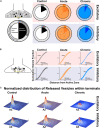Synaptic Vesicles Dynamics in Neocortical Epilepsy
- PMID: 33362472
- PMCID: PMC7758433
- DOI: 10.3389/fncel.2020.606142
Synaptic Vesicles Dynamics in Neocortical Epilepsy
Abstract
Neuronal hyperexcitability often results from an unbalance between excitatory and inhibitory neurotransmission, but the synaptic alterations leading to enhanced seizure propensity are only partly understood. Taking advantage of a mouse model of neocortical epilepsy, we used a combination of photoconversion and electron microscopy to assess changes in synaptic vesicles pools in vivo. Our analyses reveal that epileptic networks show an early onset lengthening of active zones at inhibitory synapses, together with a delayed spatial reorganization of recycled vesicles at excitatory synapses. Proteomics of synaptic content indicate that specific proteins were increased in epileptic mice. Altogether, our data reveal a complex landscape of nanoscale changes affecting the epileptic synaptic release machinery. In particular, our findings show that an altered positioning of release-competent vesicles represent a novel signature of epileptic networks.
Keywords: epilepsy; hyperexcitability; synaptic vesicles; tetanus neurotoxin; visual cortex; visual processing.
Copyright © 2020 Vannini, Restani, Dilillo, McDonnell, Caleo and Marra.
Conflict of interest statement
The authors declare that the research was conducted in the absence of any commercial or financial relationships that could be construed as a potential conflict of interest.
Figures




References
-
- Bernard C. (2010). Alterations in synaptic function in epilepsy. Epilepsia 51:42 10.1111/j.1528-1167.2010.02828.x - DOI
-
- Bromfield E. B., Cavazos J. E. (2006). Basic Mechanisms Underlying Seizures and Epilepsy - An Introduction to Epilepsy - NCBI Bookshelf. Available online at: https://www.ncbi.nlm.nih.gov/books/NBK2510/ (accessed March 13, 2020)
LinkOut - more resources
Full Text Sources
Molecular Biology Databases

